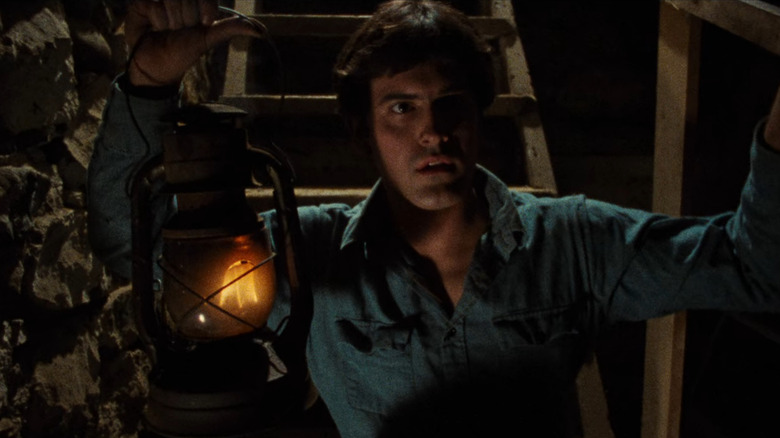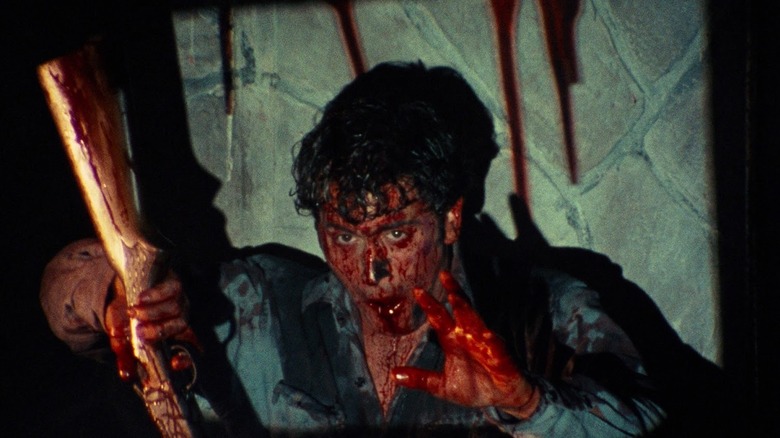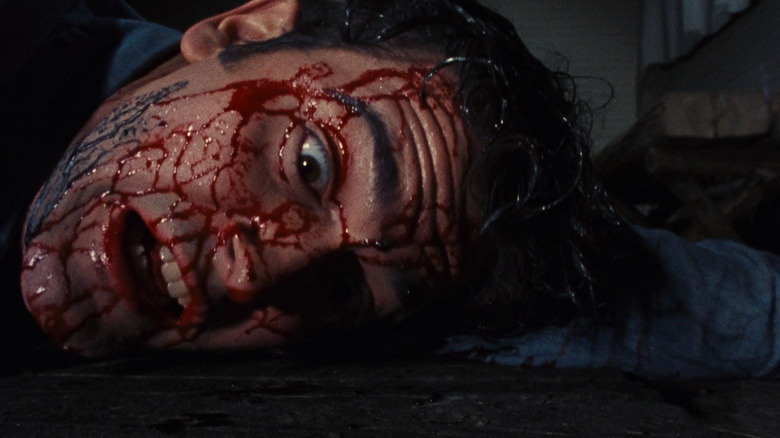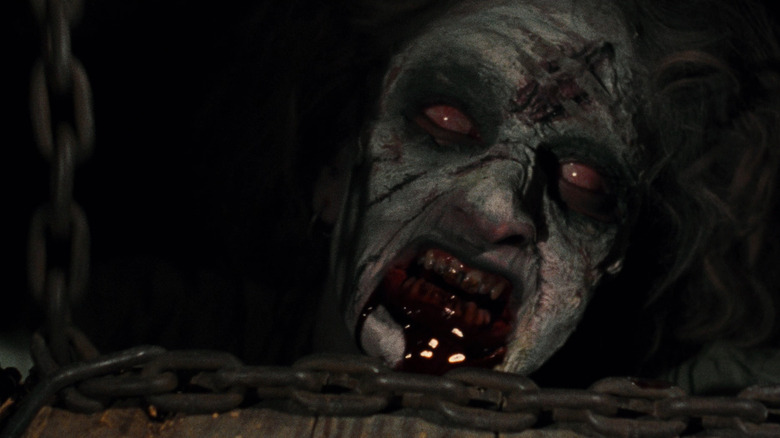The Evil Dead's Brutal Shoot Was Too Much For Most Of The Cast To Take
Anyone who has heard director Sam Raimi speak knows that shooting the 1981 low-budget horror movie "The Evil Dead" was a grueling experience. Raimi has gone on record repeatedly, describing the horrors of working in a remote cabin in freezing cold weather, trying to finish the movie in four weeks, but ultimately taking eight. Bill Warren's indispensable volume "The Evil Dead Companion" lays out every possible detail a Raimi aficionado might desire, and Raimi has described his process in multiple interviews.
"The Evil Dead," for the uninitiated, is a horror movie that took place in a remote cabin in the woods where a cadre of college students find a mysterious book bound in human flesh. The book was called the Necronomicon after an oblique spell book featured in the stories of H.P. Lovecraft. The kids play a tape recording of someone reading the Necronomicon, and it awakens an army of malevolent spirits who alternately possess and murder them. It's not long before Ash (Bruce Campbell) is the last one standing.
In what might be the film's most telling scene, Ash finds himself standing in front of a small film projector that has been splattered with blood. In the projector light, projected blood streaks down Ash's face. It's a meta moment. Ash is not being beset by demons so much as he is being victimized by the film itself. The villain in "The Evil Dead" is horror as a genre.
In a 2015 interview with IGN, Raimi laid out for the umpteenth time just how harrowing it was to shoot "The Evil Dead," recalling moments of cold and stickiness so extreme Raimi felt like he was dying.
So. Much. Blood.
One of the central props of "The Evil Dead" was its gallons and gallons of blood. Raimi has used so much blood in his movies that star Campbell has gone on record several times with the best stage blood recipe. By Campbell's measure, blood requires clear Karo syrup, powered nondairy creamer for opacity, a lot of red food coloring, with a hint of blue to darken it to a good deep shade. The blood, according to Campbell, does not taste good.
During "The Evil Dead," blood was everywhere. It's quite a bloody film. Since Karo syrup is so sticky, it coated everyone and everything. Raimi recalls having sticky hands, and needing to wash himself frequently. The only issue was a lack of tap water. Raimi had to get creative — and withstand extreme circumstances — just to get his hands clean. He said:
"There was no running water, and it was in the 20s and 30s — we didn't have any winter wear. It was freezing. When you're in that cold for 16 hours, you start to — I started to die. There was no food, and everything was covered in Karo syrup in that temperature. So I'd be running the camera, but my hands were covered in Karo syrup ... The only water we had was in a hot water heater so you could make instant coffee. Boiling water over your hands from the tap; that's how you'd wash them, to load the film into the camera."
Freezing room, boiling water, sticky, burnt hands, all just to load up cinematographer Tim Philo's Arriflex16S camera. Raimi could bear the abuse, it seems. Many others, he revealed, could not.
And then there were four
Raimi recalls how his crew dropped out of production one by one over the horrible conditions. As Raimi's four-week shoot nearly doubled in time, actors began leaving too. This also seems to have been true of even the set chef and credited transportation captain, David Goodman. Eventually, Goodman stayed in town to cook meals, and the only four remaining crew members were Raimi, Campbell, "shemp" performer Josh Becker, and producer Rob Tappert. Even Philo had left. Campbell had to take up camera duties.
Raimi claimed that having a four-person crew freed them up to be more creative. With no cogent department heads, nothing had to be cleared, and Raimi was allowed to do whatever he wanted, even if the continuity or reality didn't quite work out. Raimi remembered:
"[I]t was really the four of us ... By having to do the things ourselves — sound, lighting, photography, props, everything — I think we were allowed creativity. Everything could be dressed just so. Everything could be designed to the eye of the filmmaker, to point toward a desired effect, without any interpretation from department heads. It didn't have to make sense."
So freed, Raimi could lay out shots however strangely he wanted without a props department getting in his way. A subtle shot some "Evil Dead" fans might recognize is a scene wherein Ash, while under heavy attack from the forces of darkness, was placed in the frame to be surrounded in the background by spilled pens.
The freedom of cheapness
Raimi posited an imaginary conversation he might have had about the pen scene, saying:
"In this scene, Ash feels persecuted. 'Let's secretly take all the pens in the room, the 16 pens, and point them at Ash.' People may or may not pick up on it, but everything is indicating that he is the guilty one. That's not something you would even suggest to a prop master, because it's such a dumb idea. Continuity would have a fit, 'You can't change all the pen directions!'"
This seat-of-the-pants style of filmmaking was surely harder work, but Raimi admits that a smaller crew was not only easier to wrangle and get on the same page creatively, but permitted "dumb" ideas like this to be explored openly. What's more, a director has tighter control over his production when it's just four guys in a freezing cabin splashing blood on one another. All of a sudden, everything seemingly felt more natural. Necessity is the mother of invention. Raimi said:
"Suddenly, what was a dumb idea in the minds of other people in other departments and would break continuity is now ... everything is working toward a desired goal ... It's not something you can do except with a crew of like four on a very minuscule budget. But it was a wonderful experience in that way. [T]he harsh conditions made a [mess of] the crew, but the fact that we had to do everything ourselves did spur on our creativity."
Raimi's most recent film was the fantasy bonanza "Doctor Strange in the Multiverse of Madness," reportedly budgeted at $200 million. While Raimi has weathered numerous big-budget productions in his career, it seems that he was most creative and most in control when he was cold and covered with blood.



